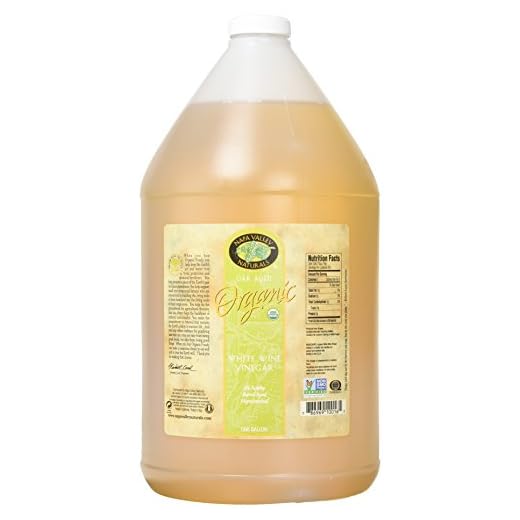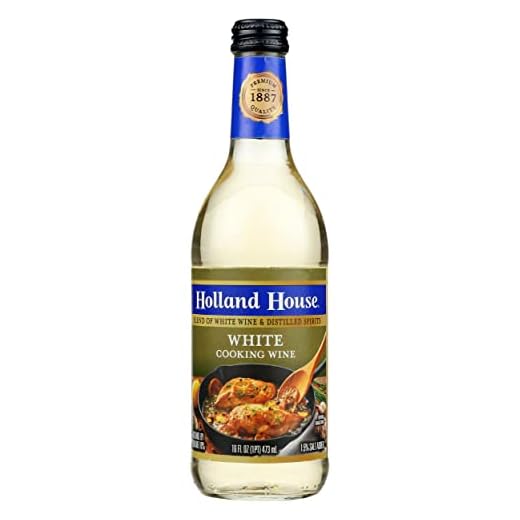

Absolutely not. While both liquids may share a similar color and are often found in kitchens, they serve distinct purposes in culinary applications. The former is typically a diluted form of fermented grape juice, designed for enhancing flavors in dishes, whereas the latter is a product of fermented alcohol, resulting in a sharp, tangy flavor profile ideal for dressings and marinades.
When selecting an ingredient for your dish, consider the intended flavor outcome. If a recipe calls for a specific ingredient, using the other could lead to an unbalanced taste. For instance, if you substitute an acidic liquid for a cooking option, you’re likely to overwhelm the dish with unexpected tartness. Conversely, using the latter in a recipe that requires a rich, fruity element might leave your meal bland and lacking depth.
It’s essential to understand these differences not only for flavor but also for cooking techniques. The former can be used to deglaze pans or add depth to sauces, while the latter is best suited for enhancing salads or pickling vegetables. Always assess your recipe requirements carefully to ensure you’re choosing the right component for the desired culinary effect.
Is White Cooking Wine the Same as White Wine Vinegar?
No, these two products are distinctly different. Cooking liquid is typically fortified, whereas the acidic counterpart is fermented from the juice of grapes, transforming sugars into acetic acid. The taste profile of each varies significantly; the former is often sweeter and less acidic, while the latter delivers a sharp tang and brightness to dishes.
When substituting, consider the dish’s requirements. If you need acidity, opt for a vinegar, but if depth and sweetness are desired, the cooking variety will do better. For recipes where alcohol is cooked off, using cooking liquid can enhance flavors without overpowering the dish. Conversely, when a dish benefits from a punch of acidity, go for vinegar.
Understanding these differences can elevate your culinary creations. Always taste before incorporating either into your recipes, adjusting quantities according to your palate and the specific flavor profile you aim to achieve.
Understanding the Ingredients of Cooking Wine
When selecting a suitable option for culinary purposes, it is crucial to know that this type of culinary liquid typically contains added salt and preservatives, which set it apart from regular beverages. It’s formulated for flavor enhancement rather than consumption as a drink. The inclusion of these additives can alter its taste profile, making it less versatile for drinking. As a result, using it in recipes can impart a different character to dishes compared to using a quality bottle intended for sipping.
Composition and Flavor Profile
This ingredient usually features a blend of various grapes, yet it may not be of the same caliber as premium selections. The flavor can range from sweet to dry, depending on the specific variety chosen. It often has a higher acidity level, which can brighten dishes, but this can also lead to an unbalanced taste if used in excess. For best results, I recommend starting with a smaller quantity and adjusting according to your palate and the dish’s requirements.
Storage and Usage Tips
Once opened, it’s best to store this culinary liquid in a cool, dark place, preferably sealed tightly. It won’t age like a fine bottle, so using it within a few months is advisable to maintain optimal flavor. Always taste before incorporating it into your recipes to ensure it complements your dish rather than overpowering it.
In summary, understanding the distinct characteristics of this ingredient can significantly enhance your culinary creations. Choose wisely and let its unique properties elevate your dishes to new heights.
Key Differences Between White Cooking Wine and White Wine Vinegar
When distinguishing between these two ingredients, several critical factors come into play that can significantly impact culinary outcomes.
Flavor Profile
- Cooking liquid typically has a mild, slightly fruity flavor profile, which enhances dishes without overpowering other ingredients.
- In contrast, the acidic counterpart offers a sharp, tangy taste that adds brightness and depth, often used to balance rich flavors.
Usage in Cooking
- The former is often utilized in sauces, braises, and marinades, contributing to the overall depth and complexity of the dish.
- The latter, however, shines in dressings, pickling, and as a finishing touch to bring out flavors in salads or cooked vegetables.
Alcohol Content
- Cooking liquid contains alcohol, which evaporates during the cooking process, imparting a subtle flavor without the effects of alcohol.
- On the other hand, the acidic ingredient contains no alcohol, making it suitable for various dietary preferences and restrictions.
Ingredient Composition
- Cooking liquid is often fortified with salt and preservatives to enhance flavor and shelf life, which can affect the sodium content in dishes.
- The acidic alternative is typically made from fermented grapes, containing no added salts, allowing for more control over seasoning.
Understanding these differences can help in making informed choices in the kitchen, ensuring the right ingredient is selected for each culinary creation.
Common Culinary Uses for White Cooking Wine
Incorporating this versatile liquid into dishes enhances flavors, especially in savory preparations. Use it to deglaze pans after sautéing meats or vegetables, allowing you to capture the rich, browned bits stuck to the bottom. This technique adds depth to sauces and gravies.
When preparing seafood, a splash can brighten the dish, complementing the natural flavors of fish and shellfish. It works beautifully in marinades, tenderizing proteins while infusing them with subtle acidity and aroma.
Popular Dishes Featuring White Cooking Wine
Consider utilizing this liquid in risottos, where it helps achieve that creamy texture while adding a light, refreshing note. It also serves well in braised dishes, particularly with chicken or pork, adding complexity to the overall flavor profile.
| Dish | Use of White Cooking Wine |
|---|---|
| Chicken Piccata | Deglazing for sauce |
| Shrimp Scampi | Cooking with garlic and butter |
| Vegetable Stir-Fry | Marinade component |
| Seafood Paella | Enhancing broth flavor |
This liquid can also add a hint of acidity to creamy dishes, balancing richness and elevating the overall taste. When baking, consider using it in savory bread recipes for added flavor complexity.
When to Substitute Cooking Wine with Wine Vinegar
Use vinegar as a substitute in dishes that require acidity to balance flavors. It’s especially effective in marinades, salad dressings, or when deglazing pans. The tanginess enhances the overall profile of the dish without compromising the intended taste.
When preparing sauces or reductions, consider using vinegar in place of cooking wine if a more pronounced acidity is desired. Just remember to adjust other ingredients to maintain harmony in the dish.
Avoid using vinegar in recipes where the primary flavor revolves around the essence of wine, such as in certain braised dishes or stews. In these cases, maintaining the original flavor profile is key.
Always start with a smaller quantity of vinegar, as its flavor can be more intense than that of cooking wine. Gradually increase to achieve the desired taste. For cleaning purposes, if you’re looking for the best cleaning products for pressure washing, vinegar can also be effective due to its natural acidity.
In summary, utilize vinegar for its acidity, but be mindful of the dish’s flavor balance and adjust accordingly.
Flavor Profiles: How They Affect Your Dishes
Incorporating diverse flavor profiles can elevate a dish significantly. Each ingredient brings its unique characteristics, influencing the overall taste and aroma. For instance, a dry fermented grape beverage can introduce acidity and depth, enhancing savory meals, while a fermented liquid derived from grape juice can provide sharpness and tang, perfect for dressings or marinades.
Understanding Acidity and Sweetness
When using a fermented grape beverage, consider its acidity. High acidity can brighten dishes, making them more refreshing. This is particularly beneficial in seafood preparations or lighter fare. Conversely, a tangy liquid can add a contrasting sharpness, balancing rich and creamy elements, such as in creamy sauces or buttery vegetables.
Pairing Considerations
Pairing ingredients with complementary profiles is crucial. For heartier meals, opt for a robust fermented beverage that can withstand bold flavors. On the other hand, for delicate dishes, a lighter option will prevent overpowering the primary ingredients. Testing different combinations can lead to delightful surprises, enhancing both taste and presentation.
Storage and Shelf Life of Cooking Wine vs. Vinegar
To maintain optimal quality, store cooking liquid in a cool, dark place, tightly sealed after each use. It generally lasts 1-2 months after opening, though refrigeration can extend its lifespan. Check for off-odors or discoloration before use.
On the other hand, the fermented acid can last much longer. Once opened, it can remain good for 1-3 years if sealed properly and kept in a cool location. Always inspect for changes in smell or appearance before incorporating into recipes.
Tips for Proper Storage
- Keep bottles upright to prevent cork damage.
- Avoid exposure to heat sources and direct sunlight.
- Label bottles with opening dates for better tracking.
Signs of Spoilage
- Unpleasant odors or off-flavors.
- Cloudiness or sediment formation.
- Change in color or consistency.







